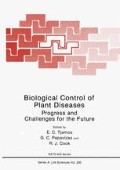Abstract
Nematophagous fungi have been studied for more than a century and at least three species have been developed as commercial biological control agents (BCA’s). However, none is in widespread use because satisfactory and consistent levels of control have not been achieved (Kerry, 1987; Stirling, 1988). This is largely due to a lack of detailed information on the modes of action, ecology and epidemiology of those fungi considered to have potential as BCA’s. Most studies have been empirical and experiments purporting to demonstrate biological control rarely include evidence of the proliferation and survival of the agent in soil or data on the numbers of nematodes infected and killed (Kerry, 1990a). There is a need for in depth studies of model systems using agents with different modes of action to determine the key factors involved in the biological control of specific nematode pests.
Access this chapter
Tax calculation will be finalised at checkout
Purchases are for personal use only
Preview
Unable to display preview. Download preview PDF.
Literature Cited
Eayre, C. G., Jaffee, B. A., and Zehr, E. I., 1987, Suppression of Criconemalla xenoplax by the nematophagous fungus Hirsutella rhossiliensis, Plant Dis., 71: 832.
Irving, F., and Kerry, B. R., 1986, Variation between strains of the nematophagous fungus Verticillium chlamydosporium Goddard. II. Factors affecting parasitism of cyst nematode eggs, Nematologica, 32: 474.
Kerry, B. R., 1987, Biological control, in: “Principles and Practice of Nematode Control in Crops”, R. H. Brown and B. R. Kerry, eds., Academic Press, Sydney.
Kerry, B. R., 1988, Two microorganisms for the biological control of plant parasitic nematodes, Proceedings of the Brighton Crop Protection Conference - Pests and Diseases, 603.
Kerry, B. R., 1989, Fungi as biological control agents for plant parasitic nematodes, in: “Biotechnology of Fungi for Improving Plant Growth”, J. M. Whipps and R. D. Lumsden, eds., Cambridge University Press, Cambridge.
Kerry, B. R., 1990a, Selection of exploitable biological control agents for plant-parasitic nematodes, Aspects Appl. Biol., 24: 1.
Kerry, B. R., 1990b, An assessment of progress toward microbial control of plant-parasitic nematodes, Ann. Appl. Nematol., 4: 621.
Kerry, B. R., Simon, A., and Rovira, A. D., 1984, Observations on the introduction of Verticillium chlamydosporium and other parasitic fungi into soil for control of the cereal cyst-nematode Heterodera avenae, Ann. Appl. Biol., 105: 509.
Leij, de, F. A. A. M, and Kerry, B. R., 1991, The nematophagous fungus, Verticillium chlamydosporium Goddard, as a potential biological control agent for Meloidogyne arenaria (Neal) Chitwood, Res. Nematol., 14: 157.
Morgan-Jones, G., White, J. F., and Rodriguez-Kabana, R., 1983, Phytonematode pathology: Ultrastructural studies I. Parasitism of Meloidogyne arenaria eggs by Verticillium chlamydosporium, Nematropica 13: 245.
Rodriguez-Kabana, R., and Morgan-Jones, G., 1988, Potential for nematode control by mycofloras endemic in the tropics, J. Nematol., 20: 191.
Stirling, G. R., 1988, Biological control of plant-parasitic nematodes, in: “Diseases of Nematodes, vol. 2”, G. O. Poinar and H. B. Jansson, eds., CRC Press, Boca Raton, FL.
Stirling, G. R., McKenry, M. V., and Mankau, R., 1979, Biological control of root-knot nematodes (Meloidogyne spp.) on peach, Phytopathology, 69: 806.
Author information
Authors and Affiliations
Editor information
Editors and Affiliations
Rights and permissions
Copyright information
© 1992 Springer Science+Business Media New York
About this chapter
Cite this chapter
Kerry, B.R., de Leij, F.A.A.M. (1992). Key Factors in the Development of Fungal Agents for the Control of Cyst and Root-Knot Nematodes. In: Tjamos, E.C., Papavizas, G.C., Cook, R.J. (eds) Biological Control of Plant Diseases. NATO ASI Series, vol 230. Springer, Boston, MA. https://doi.org/10.1007/978-1-4757-9468-7_19
Download citation
DOI: https://doi.org/10.1007/978-1-4757-9468-7_19
Publisher Name: Springer, Boston, MA
Print ISBN: 978-1-4757-9470-0
Online ISBN: 978-1-4757-9468-7
eBook Packages: Springer Book Archive

